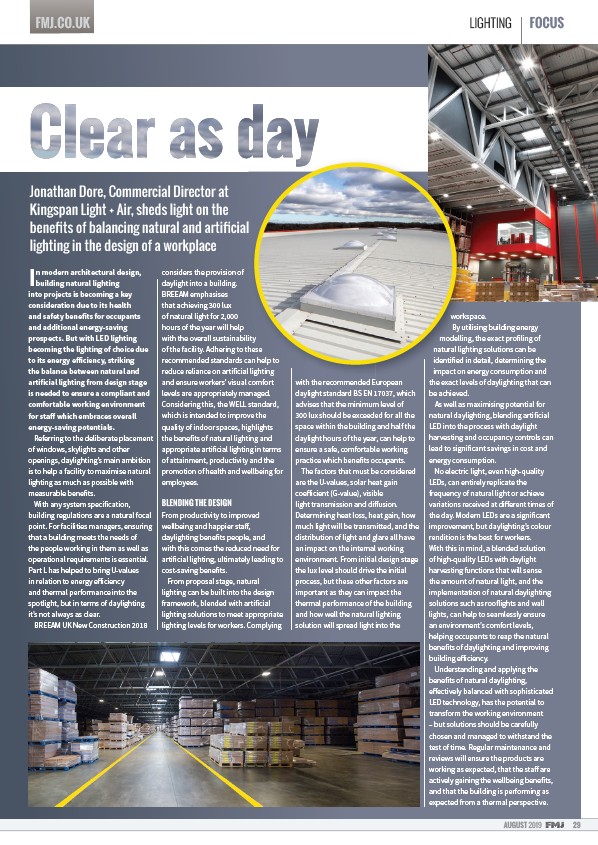
FMJ.CO.UK LIGHTING FOCUS
AUGUST 2019 29
Jonathan Dore, Commercial Director at
Kingspan Light + Air, sheds light on the
benefi ts of bDODnFLnJ nDtXUDO DnG DUtLfi FLDO
OLJhtLnJ Ln the GesLJn of D ZoUNSODFe
In modern architectural design,
building natural lighting
into projects is becoming a key
consideration due to its health
and safety benefits for occupants
and additional energy-saving
prospects. But with LED lighting
becoming the lighting of choice due
to its energy e iciency, striking
the balance between natural and
artificial lighting from design stage
is needed to ensure a compliant and
comfortable working environment
for sta which embraces overall
energy-saving potentials.
Referring to the deliberate placement
of windows, skylights and other
openings, daylighting’s main ambition
is to help a facility to maximise natural
lighting as much as possible with
measurable benefits.
With any system specification,
building regulations are a natural focal
point. For facilities managers, ensuring
that a building meets the needs of
the people working in them as well as
operational requirements is essential.
Part L has helped to bring U-values
in relation to energy e iciency
and thermal performance into the
spotlight, but in terms of daylighting
it’s not always as clear.
BREEAM UK New Construction 2018
considers the provision of
daylight into a building.
BREEAM emphasises
that achieving 300 lux
of natural light for 2,000
hours of the year will help
with the overall sustainability
of the facility. Adhering to these
recommended standards can help to
reduce reliance on artificial lighting
and ensure workers’ visual comfort
levels are appropriately managed.
Considering this, the WELL standard,
which is intended to improve the
quality of indoor spaces, highlights
the benefits of natural lighting and
appropriate artificial lighting in terms
of attainment, productivity and the
promotion of health and wellbeing for
employees.
BLENDING THE DESIGN
From productivity to improved
wellbeing and happier sta ,
daylighting benefits people, and
with this comes the reduced need for
artificial lighting, ultimately leading to
cost-saving benefits.
From proposal stage, natural
lighting can be built into the design
framework, blended with artificial
lighting solutions to meet appropriate
lighting levels for workers. Complying
with the recommended European
daylight standard BS EN 17037, which
advises that the minimum level of
300 lux should be exceeded for all the
space within the building and half the
daylight hours of the year, can help to
ensure a safe, comfortable working
practice which benefits occupants.
The factors that must be considered
are the U-values, solar heat gain
coe icient (G-value), visible
light transmission and di usion.
Determining heat loss, heat gain, how
much light will be transmitted, and the
distribution of light and glare all have
an impact on the internal working
environment. From initial design stage
the lux level should drive the initial
process, but these other factors are
important as they can impact the
thermal performance of the building
and how well the natural lighting
solution will spread light into the
workspace.
By utilising building energy
modelling, the exact profiling of
natural lighting solutions can be
identified in detail, determining the
impact on energy consumption and
the exact levels of daylighting that can
be achieved.
As well as maximising potential for
natural daylighting, blending artificial
LED into the process with daylight
harvesting and occupancy controls can
lead to significant savings in cost and
energy consumption.
No electric light, even high-quality
LEDs, can entirely replicate the
frequency of natural light or achieve
variations received at di erent times of
the day. Modern LEDs are a significant
improvement, but daylighting’s colour
rendition is the best for workers.
With this in mind, a blended solution
of high-quality LEDs with daylight
harvesting functions that will sense
the amount of natural light, and the
implementation of natural daylighting
solutions such as rooflights and wall
lights, can help to seamlessly ensure
an environment’s comfort levels,
helping occupants to reap the natural
benefits of daylighting and improving
building e iciency.
Understanding and applying the
benefits of natural daylighting,
e ectively balanced with sophisticated
LED technology, has the potential to
transform the working environment
– but solutions should be carefully
chosen and managed to withstand the
test of time. Regular maintenance and
reviews will ensure the products are
working as expected, that the sta are
actively gaining the wellbeing benefits,
and that the building is performing as
expected from a thermal perspective.